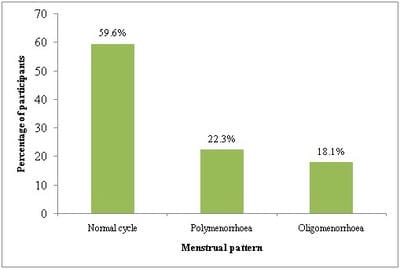Prevalence and pattern of menstrual disorders among school going adolescents in northern district of Kerala
Antherjanam S D.1*, Karunakaran U.2, Jayasree A K.3, Antony R.4, Anitha S S.5, Harsha C H.6
DOI: https://doi.org/10.17511/ijphr.2016.i3.04
1* Devaki Antherjanam S, Assistant Professor, Department of Community Medicine, Sree Narayana Institute of Medical Sciences, Kunnukara, Kerala, India.
2 Usha Karunakaran, Associate Professor, Department of Community Medicine, Academy of Medical Sciences, Pariyaram, Kerala, India.
3 Jayasree A K, Professor, Depertment of Community Medicine, Academy of Medical Sciences, Pariyaram, Kerala, India.
4 Raju Antony, Professor, Department of Community Medicine, Sree Narayana Institute of Medical Sciences, Kunnukara, Kerala, India.
5 Anitha S S., Assistant Professor, Department of Community Medicine, Academy of Medical Sciences, Pariyaram, Kerala, India.
6 Harsha C H, Assistant Professor, Department of Biostatistics, Sree Narayana Institute of Medical Sciences, Kunnukara, Kerala, India.
Background: Adolescents face a range of health challenges, numerous information and guidance regarding adolescent health remaining ignored due to constraints at different levels of health system.One of the main problems among adolescent girls are irregular menstruation, excessive bleeding and dysmenorrhoea. Menstrual irregularities during adolescent period have association with reproductive morbidities in adulthood. Objective: To study the prevalence and pattern of menstrual disorders and its associated factors among IX to XII class adolescent girls in Kannur district. Methods: Cross-sectional study among school going adolescent Girls from class IX to XII in Kannur District. Results: Among the 1722 study participants, 48.8% had menstrual disorders, in which dysmenorrhoea is the most common menstrual disorder reported 71.5%. The risk factors like rural residence, lower socio-economic status, mixed diet, non-consumption of egg, not physically active both during routine life and also during menstruation, increased BMI showed a significant association with menstrual disorder among the study participants. Conclusion: Use of services by adolescents is limited may be due to lack of adequate privacy and confidentiality and judgemental attitudes of service providers, who often lack counselling skills. Therefore, effective services like assurance of confidentiality, psychological support, counselling is necessary.
Keywords: Adolescence, Menstrual disorder, School going
| Corresponding Author | How to Cite this Article | To Browse |
|---|---|---|
| , Assistant Professor, Department of Community Medicine, Sree Narayana Institute of Medical Sciences, Kunnukara, Kerala, India. Email: |
Antherjanam S D, Karunakaran U, Jayasree A K, Antony R, Anitha S S, Harsha C H. Prevalence and pattern of menstrual disorders among school going adolescents in northern district of Kerala. Public Health Rev Int J Public Health Res. 2016;3(3):109-118. Available From https://publichealth.medresearch.in/index.php/ijphr/article/view/40 |


 ©
© 